One of the most challenging tasks for due diligence teams on the lookout for connections to money laundering, bribery, corruption is to uncover the identities of ultimate beneficial owners of entities, properties, and third-party business partners.
The job of understanding who companies, and financial services organisations in particular, are doing business with has been made all the more difficult by complex ownership trails that cross geographical and legal boundaries. Criminal elements exploit such methods to obscure the real identities of the person or persons who ultimately benefit from financial transactions.
 When the OECD reviewed 400-plus bribery cases across 41 countries for its 2014 report An Analysis of the Crime of Bribery of Foreign Public Officials, it found that one in four of them had involved illicit money channelled through shadowy secret companies. The World Bank has estimated that corrupt politicians used secret companies to obscure their identities in 70 per cent of more than 200 cases of grand corruption.
When the OECD reviewed 400-plus bribery cases across 41 countries for its 2014 report An Analysis of the Crime of Bribery of Foreign Public Officials, it found that one in four of them had involved illicit money channelled through shadowy secret companies. The World Bank has estimated that corrupt politicians used secret companies to obscure their identities in 70 per cent of more than 200 cases of grand corruption.
The New York Times reported in 2014 that an estimated 8% – more than US$7 trillion – of the world’s personal financial wealth is held in undeclared offshore deposits. Opportunities to illicitly transfer or hide money through complex networks of companies deliberately created to mask the details of ultimate beneficiaries.
LexisNexis published recently a white paper which explains what beneficial ownership is, why it is a problem; what is being done about it, and the measures companies can take to protect themselves against the potential implications of not knowing who they are ultimately doing business with.
To download the White Paper click on this link






















